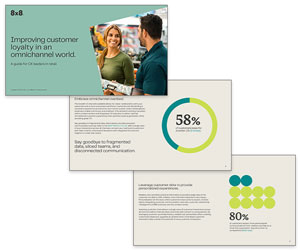The topic of digital transformation has been discussed for decades, but has increasingly been brought up in boardroom meetings, conferences, and online networks over the past couple of years as the pandemic forced organizations to take a cloud-first, digital-first approach.
Further examination of C-suite executives’ playbooks suggests that the conversations around accelerating digital transformation won’t be subsiding anytime soon.
Nearly 90% of CIOs plan to increase investment in digital transformation over the next three to five years, despite the ups and downs of the global economy.
Most business leaders are hoping to emerge from their digital metamorphosis with expedited processes and exponential profits.
But it’s how businesses envision this transformation that will separate those that actually achieve it from the ones that don’t.
The most savvy business leaders recognize that throwing money at the problem is but one part of a larger equation—with the key factor being scalable omnichannel communications.
The Pressing Need for Scalable Omnichannel Communications
Communication is as vital to business as water is to our ecology. It’s how customers make purchases or gain information that leads to purchases.
It’s how teams collaborate to come up with products that customers actually want to purchase, and it’s how partnerships are established to make those products a reality.
Real-time communications (RTC) technology, like chat applications, video conferencing, and voice channels, has made it much easier for businesses to process larger volumes of conversations and accelerate business decisions.
Demand for such communication channels was further popularized during the pandemic, and it has remained high in today’s hybrid working model.
The problem with current RTCs on the market, however, is that they isolate conversations in silos. Incoming calls are still confined within customer service centers, with little information being allowed to circulate across marketing, sales, and business development teams. This is despite the fact that they all serve the same audience: the customer.
Thus far, businesses have gotten by with the tools available at their disposal. But rising customer expectations for digital-first service and a ballooning middle class in developing nations means that the current system will sooner or later reach a tipping point. Many businesses’ systems already have.
How Different Departments Collaborate and Communicate Better with CPaaS
To clear the path moving forward, businesses can employ two strategies: removing blockades within inter-department communication pipelines and tapping into automation to smoothen the flow of customer communications.
And Communications Platform as a Service (CPaaS) providers allow businesses to do exactly that. CPaaS integrates real-time communication into existing business applications, so that they can experience the perks of an upgrade without any of the downtime.
Here’s what that will look like:
How CPaaS Makes it Easier for Human Resources (HR) to Excel at Their Jobs
Company-wide announcements, individualized birthday notifications, and more can both be scheduled through omnichannel communication platforms, ensuring that no employee is left out of the loop for both big business developments and celebratory events.
But the real game changer comes with interactive, self-service menus that provide employees with access to guides and tutorials that can aid them along their upskilling journey.
These self-serve menus increase operational efficiency, so that HR teams do not have to spend time guiding employees to the right assets. At the same time, employee feedback can be easily collected with the help of SMS Engage.
Rather than schedule mass educational sessions that may be lodged between important deadlines, HR departments can address the concerns of 42% of the workforce by giving employees more autonomy and opportunity for personal development.
Finally Working Together: How CPaaS Optimizes Omnichannel Customer Service and Marketing
CPaaS brings customer service and marketing teams together with real-time, omnichannel-based analytics that give more insights into customer sentiment.
Data within automated ticketing systems and customer profiles can be aggregated to give marketing teams insight into where the majority of customers are along their consumer journey.
This allows them to plan campaigns that are relevant for their target audience, which can then be launched across multiple channels.
Beyond that, marketing teams can also strategically create communications that customer service teams can then push to customers to resell or upsell services where relevant.
In this way, automation-assisted customer service teams and marketing teams can create a self-reinforcing cycle where both processes are continuously refined allowing businesses to not only provide enticing offers, but stay relevant amidst a time of change.
Safeguarding the Fort: How CPaaS Helps Finance and IT
If money makes the world go round, then finance teams keep the lights on by ensuring that the right people pay, and get paid.
Of course, in a world rampant with fraudulent links and digital impersonators, finance teams can safeguard transactions through SMS-enabled two-factor authentication (2FA).
But beyond the mandatory failsafe mechanism, SMS communications also help with clarity, precision, and timely responses when dealing with something as sensitive as finance.
Finally, linking financial records with the IT and cybersecurity department can ensure that threats and errors are resolved within the shortest time possible.
This can be done through automated alerts via SMS and commonly used chat apps, alerting both teams of anomalies, such as sudden changes in transaction volume or suspicious activity.
How Communication APIs Create the Connector Between Silos
Remember, a company is only as strong as its weakest link. So, to emerge in the era of accelerated digital transformation with expedited processes and increased profits, businesses must look beyond the glitzy tech options and make sure that the best and right technology is applied.
They need a solution that can ease one of the most important and difficult aspects of running any business: internal and external communication.
This is why many forward-thinking businesses are turning to communication APIs. These communication solutions keep teams moving together by building lines of communication between C-suite executives, departments, and the end-customer, so that everyone can work in unison to improve situations on the ground.
With Communication APIs, all departments can look forward to streamlining processes, weeding out redundancies, and establishing connections between key partners, all without spending hours on coding. With those strong foundations in place, the business then has the tools it needs to scale.
This blog post has been re-published by kind permission of 8x8 – View the Original Article
For more information about 8x8 - visit the 8x8 Website
Call Centre Helper is not responsible for the content of these guest blog posts. The opinions expressed in this article are those of the author, and do not necessarily reflect those of Call Centre Helper.
Author: 8x8
Published On: 21st Apr 2023
Read more about - Guest Blogs, 8x8






 8x8 is transforming the future of business communications as a leading Software-as-a-Service provider of voice, video, chat, contact centre, and enterprise-class API solutions, powered by one global cloud communications platform.
8x8 is transforming the future of business communications as a leading Software-as-a-Service provider of voice, video, chat, contact centre, and enterprise-class API solutions, powered by one global cloud communications platform. 










